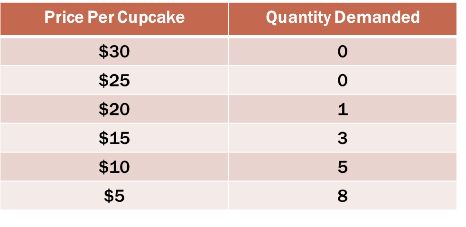What is Demand?
Remember from the introduction that demand in economics has three parts. People must have:
desire
ability
willingness
to purchase a good or service for demand to be created.

Demand?
Based on the definition of demand, which of the objects below would the average consumer be most likely to demand and why?



Individual Demand Schedule
A demand schedule is a list that illustrates the possible quantities demanded of a good/service at the prices that might work in the market at a particular time.
Demand Schedule Example
The demand schedule below illustrates that a certain consumer would not buy any cupcakes at a price of $25 or $30, but would buy one if the price dropped to $20, and even more would be sold if the price was only five dollars.

Individual Demand Curve
The demand schedule information from the cupcake example can also be shown in graph form. The graph is called the individual demand curve, which is just a graph showing the quantity of demand for a certain individual at each price that might be used in the market at a given time.
Demand Curve Example
In this example, the demand curve slopes downward. This shows that people are normally willing to buy less of a product at a high price and more at a low price.
According to the law of demand, quantity demanded and price move in opposite directions.

Law of Demand
The Law of Demand means that the quantity demanded of a good/service varies inversely with its price. In other words, when the price is high, the quantity demanded goes down.
A high price discourages people from buying a product. As the price of a product rises, consumers will buy less of it.
Price Demand
Demand
Market Demand Curve
Remember that an individual demand curve is a graph showing the quantity of demand for a certain individual at each price that might be used in the market at a given time. Sometimes we need to know the quantities demanded by everyone who is interested in buying a product. Such a demand curve is called the market demand curve.
Demand and Marginal Utility
Utility is the amount of usefulness/satisfaction one gets from using a product.
Marginal utility is the extra usefulness/satisfaction one gets from getting or using one more unit of a product.
Diminishing Marginal Utility
We buy things because we feel the product is useful to us, but as we use more and more of a product we experience diminishing marginal utility.
The principle of diminishing marginal utility states that the satisfaction we gain from buying a product lessens as we buy more of the same product.
As we use more of a product, we are not willing to pay as much for it. Therefore, the demand curve is downward sloping.
Review
1. Explain the relationship between the demand schedule and demand curve.
2. Explain how the slope of the demand curve can be explained by the principle of diminishing marginal utility.